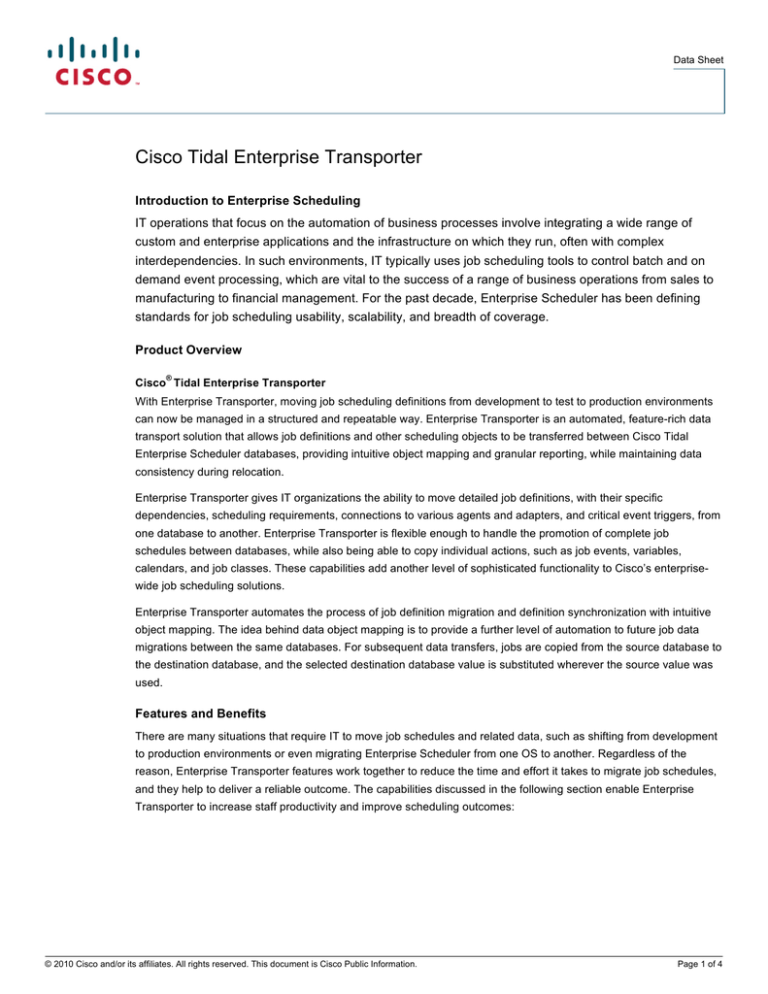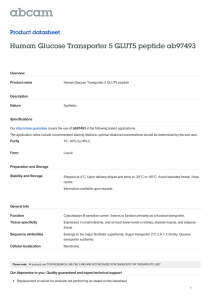
Data Sheet
Cisco Tidal Enterprise Transporter
Introduction to Enterprise Scheduling
IT operations that focus on the automation of business processes involve integrating a wide range of
custom and enterprise applications and the infrastructure on which they run, often with complex
interdependencies. In such environments, IT typically uses job scheduling tools to control batch and on
demand event processing, which are vital to the success of a range of business operations from sales to
manufacturing to financial management. For the past decade, Enterprise Scheduler has been defining
standards for job scheduling usability, scalability, and breadth of coverage.
Product Overview
®
Cisco Tidal Enterprise Transporter
With Enterprise Transporter, moving job scheduling definitions from development to test to production environments
can now be managed in a structured and repeatable way. Enterprise Transporter is an automated, feature-rich data
transport solution that allows job definitions and other scheduling objects to be transferred between Cisco Tidal
Enterprise Scheduler databases, providing intuitive object mapping and granular reporting, while maintaining data
consistency during relocation.
Enterprise Transporter gives IT organizations the ability to move detailed job definitions, with their specific
dependencies, scheduling requirements, connections to various agents and adapters, and critical event triggers, from
one database to another. Enterprise Transporter is flexible enough to handle the promotion of complete job
schedules between databases, while also being able to copy individual actions, such as job events, variables,
calendars, and job classes. These capabilities add another level of sophisticated functionality to Cisco’s enterprisewide job scheduling solutions.
Enterprise Transporter automates the process of job definition migration and definition synchronization with intuitive
object mapping. The idea behind data object mapping is to provide a further level of automation to future job data
migrations between the same databases. For subsequent data transfers, jobs are copied from the source database to
the destination database, and the selected destination database value is substituted wherever the source value was
used.
Features and Benefits
There are many situations that require IT to move job schedules and related data, such as shifting from development
to production environments or even migrating Enterprise Scheduler from one OS to another. Regardless of the
reason, Enterprise Transporter features work together to reduce the time and effort it takes to migrate job schedules,
and they help to deliver a reliable outcome. The capabilities discussed in the following section enable Enterprise
Transporter to increase staff productivity and improve scheduling outcomes:
© 2010 Cisco and/or its affiliates. All rights reserved. This document is Cisco Public Information.
Page 1 of 4
Data Sheet
Multiple Scheduling Environment Coverage – For organizations using Enterprise Scheduler with multiple
scheduling environments, Transporter automates the migration of jobs among databases, eliminating the need to
manually re-key jobs definitions. A typical multi-scheduling environment is comprised of separate development, test,
and production environments, and Enterprise Transporter is designed to move thousands of scheduler definitions—
including jobs, job classes, job groups, calendars, events, actions, and variables—among these different databases
in seconds.
Enterprise Transporter users can easily locate jobs and parameters using advanced filtering criteria. Search criteria
can include job, group, command, agent, owner, job class, job groups, and jobs that are active or not, or any
combination of these. Objects and attributes can also be located using wildcard characters, which offer a wider
variety of search options. The result is a reduction in the time required for volume job migration projects when
hundreds or even thousands of jobs must be tested and released into production environments.
Job Lifecycle Management – Most data centers have constant job change/migration activities as applications and
databases are brought online, updated, or retired. IT Operations needs an orderly and staged migration solution that
minimizes risk and disruptions to job scheduling activities when new jobs and events are moved to production states.
With Enterprise Transporter, jobs can be tested and migrated in large groups and configured to become active
immediately or scheduled to become active at any future date.
During the production cycle of job definitions, Enterprise Transporter can be used to consolidate, decentralize, or split
job databases among multiple Enterprise Scheduler environments, minimizing costly manual intervention. Enterprise
Transporter can also make universal database changes, such as assigning existing jobs to different agents, thereby
increasing IT staff efficiency and agility when facing complex environmental changes.
Changes to an Enterprise Scheduler OS Platform – Moving Enterprise Transporter job definitions between
different OS environments is also possible as long as the Enterprise Scheduler versions are the same. For example,
if a company chooses to move an Enterprise Scheduler from a Windows server to a UNIX server, Enterprise
Transporter reduces the job database transfer time to minutes, making job scheduling migration seamless.
Automation for the Transition from Ad Hoc to Scheduled Jobs – Many data centers create ad hoc jobs that need
to run immediately. Gradually, these ad hoc jobs are reused and fall into predictable patterns. They then need to be
organized into particular calendars or schedules. With Enterprise Transporter, ad hoc jobs can be easily transferred
to standard production runs, eliminating manual intervention in the job scheduling process. Using Enterprise
Transporter also gives IT Operations staff the ability to incorporate migration processes into established IT policies
and to seamlessly make changes to run book operations.
Rich User Interface – An intuitive user interface provides visual choices for jobs, groups, agents, calendars, and
schedules, eliminating guesswork and errors. This utility points out differences in a target environment such as
calendars that do not exist, enabling users to select an appropriate calendar.
Rule-Based Mapping – Rule-based mapping adds automated intelligence to job migrations. IT staff can use object
mapping to control environment settings, setting them once or mapping as they proceed. The UI guides users
through the process of mapping calendars and variables, testing targets and events, and correcting connections to
agents. Once completed, these objects can be applied as rules to entire sets of jobs as global changes, such as
connecting a new agent to many jobs.
© 2010 Cisco and/or its affiliates. All rights reserved. This document is Cisco Public Information.
Page 2 of 4
Data Sheet
Data Integrity Support – Integrity of the job database is maintained through internal synchronization features.
Manual migration mistakes can be avoided, because using rules can normalize agent naming discrepancies and
eliminate selecting the wrong agent.
Migration Timing Control – Enterprise Transporter can move Enterprise Scheduler definitions from one database to
another while running in live production environments, with no need to stop active job instances. Jobs can also be
moved at a set time in the future through a standard calendaring function.
Advanced Error Checking – Advanced error checking catches potential problems before they affect schedule
execution results, minimizing costly mistakes.
Feature Summary
The following features make the capabilities of Enterprise Transporter easily accessible to users, enabling them to become productive
quickly:
•
Easy-to-use graphical user interface with features such as drag-and-drop from source database to destination database
•
The ability to migrate complete jobs, job classes, job groups, calendars, events, actions, and variables between Enterprise
Scheduler databases
•
A search function that simplifies finding job and job components
•
Extensive filters and job trees that simplify browsing through jobs
•
The ability to modify ad hoc jobs and change definitions during migration
•
The ability to add, delete, and test database connections
•
Comprehensive logging and audit reporting
•
An annotation feature to add notes on job transfers
•
Rule mapping to automate global changes and resolve agent, calendar, owner, runtime user, and other conflicts
•
An interactive mode that dynamically maps items and applies the changes to remaining jobs
•
Configuration and desktop settings saved between sessions
•
Processes integrated into existing IT policies and run book operations
Key Requirements
Cisco Tidal Enterprise Transporter is designed to work with Cisco Tidal Enterprise Scheduler.
Although specific planning and sizing is straightforward, actual requirements can vary by enterprise depending on the
environment and type of coverage needed. Specific requirements information is easily obtainable after an initial
conversation with a product expert. Enterprise Transporter can be installed and deployed by the customer or by
engaging Cisco Services. An array of materials is also available online through Cisco Knowledge Services.
About Cisco Tidal Enterprise Scheduler
Cisco Tidal Enterprise Scheduler drives efficiency by centralizing and providing a single view of cross-enterprise job
scheduling events. This powerful, yet easy-to-use solution enables organizations to assemble complex batch job and
business process schedules that span the enterprise. With its ability to closely monitor scheduled jobs, automatically
detect problems, and define actions to aid in recovery, business process performance can be greatly enhanced.
With the broad coverage provided by Enterprise Scheduler, IT operations teams can effectively schedule processes
that touch a wide range of databases, systems, and applications. They can also easily incorporate and manage new
applications as they come online, which helps improve the operation of mission-critical business processes as the
enterprise expands and evolves.
© 2010 Cisco and/or its affiliates. All rights reserved. This document is Cisco Public Information.
Page 3 of 4
Data Sheet
Companies in a variety of industries rely on Cisco Tidal Enterprise Scheduler to keep their daily operations running
smoothly. Cisco Tidal enterprise job scheduling software and application performance management solutions can
deliver even greater levels of automation and optimization to the data center than conventional scheduling and
performance management solutions.
For More Information
For more information about this or any other Cisco product or service please visit www.cisco.com.
Printed in USA
© 2010 Cisco and/or its affiliates. All rights reserved. This document is Cisco Public Information.
1126-B
07/10
Page 4 of 4



